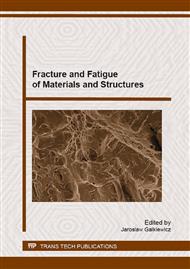[1]
S. Kocanda, Fatigue failure of metals, WNT, Warszawa, (1985).
Google Scholar
[2]
D. Rozumek, E. Macha, A description of fatigue crack growth in elastic-plastic materials under proportional bending with torsion, Opole University of Technology, Opole, 2006 (in Polish).
DOI: 10.1111/j.1460-2695.2006.00972.x
Google Scholar
[3]
S. Beretta, S. Foletti, K. Valiullin, Fatigue strength for small shallow defects/cracks in torsion, International Journal Fracture 33 (2011) 287-299.
DOI: 10.1016/j.ijfatigue.2010.08.014
Google Scholar
[4]
M. Gladskyi, A. Fatemi, Notched fatigue behavior including load sequence effects under axial and torsional loadings, International Journal Fracture 55 (2013) 43-53.
DOI: 10.1016/j.ijfatigue.2013.05.003
Google Scholar
[5]
J. Pokluda, R. Pippan, Can pure mode III fatigue loading contribute to crack propagation in metallic materials? Fatigue & Fracture of Engineering Materials & Structures 28 (2005) 179-185.
DOI: 10.1111/j.1460-2695.2004.00843.x
Google Scholar
[6]
E. K. Tschegg, A contribution to mode III fatigue crack propagation, Materials Science and Engineering 54 (1982) 127-136.
DOI: 10.1016/0025-5416(82)90037-4
Google Scholar
[7]
D. Rozumek, Z. Marciniak, The investigation of crack growth in specimens with rectangular cross-sections under out-of-phase bending and torsional loading, International Journal of Fatigue 39 (2012) 81–87.
DOI: 10.1016/j.ijfatigue.2011.02.013
Google Scholar
[8]
J. R. Yates, K. J. Miller, Mixed mode (I+III) fatigue thresholds in a forging steel, Fatigue & Fracture of Engineering Materials & Structures 12 (1989) 259-270.
DOI: 10.1111/j.1460-2695.1989.tb00532.x
Google Scholar
[9]
A. Thum, C. Petersen, O. Swenson, Verformung, Spannung und Kerbwirkung, VDI, Duesseldorf (1960).
Google Scholar
[10]
D. Rozumek, M. Hepner, S. Faszynka, Influence of the titanium and its alloys microstructure on the fatigue crack paths, Key Engineering Materials 592-593 (2014) 692-695.
DOI: 10.4028/www.scientific.net/kem.592-593.692
Google Scholar
[11]
S. Faszynka, D. Rozumek, J. Lewandowski, Crack growth path in specimens with rectangular section under bending with torsion, Solid State Phenomena 224 (2015) 133-138.
DOI: 10.4028/www.scientific.net/ssp.224.133
Google Scholar


